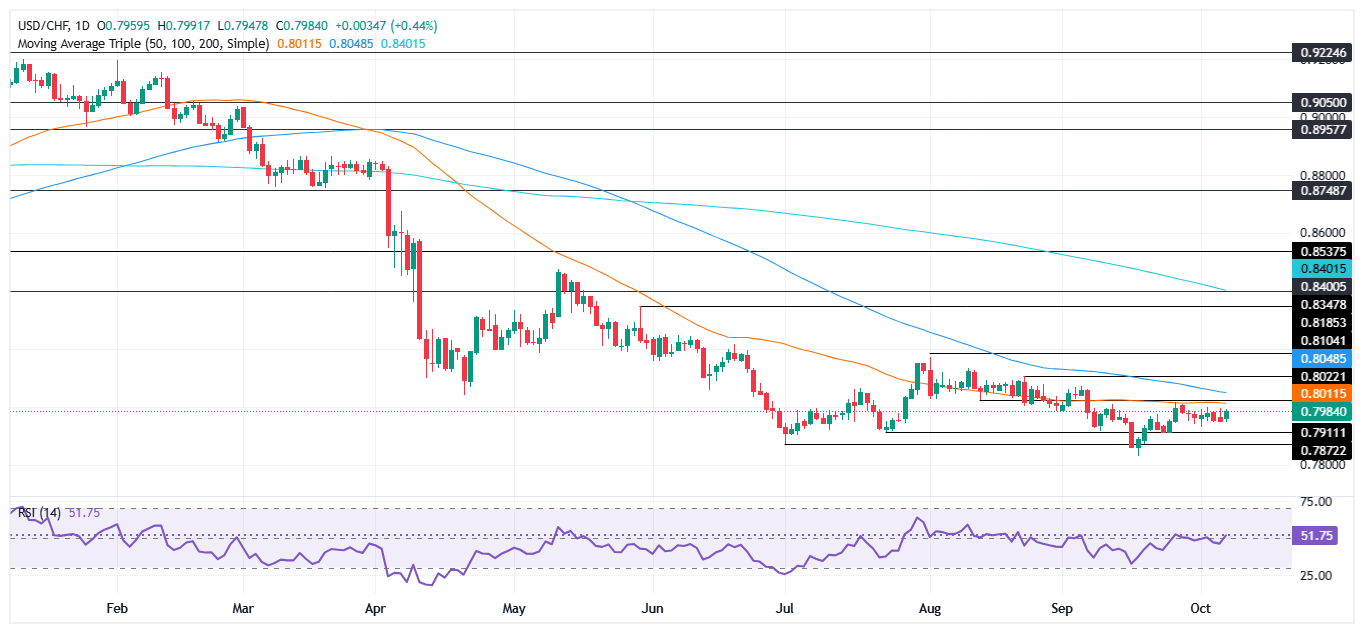USD/CHF Price Forecast: Stuck near yearly lows below 0.8000
- USD/CHF trades sideways, capped between the 20- and 50-day SMAs, signaling indecision among traders.
- RSI turns slightly bullish but flat slope hints at limited near-term momentum and range-bound behavior.
- Break below 0.7950 opens path toward 0.7829 yearly low; upside capped at 0.8008 and 0.8045 resistance.
The USD/CHF trades at around yearly lows of 0.7980, capped on the downside by the 20-day Simple Moving Average (SMA) of 0.7951 and by the 50-day SMA at 0.8008. At the time of writing, the pair hovers around 0.7980, virtually unchanged.
USD/CHF Price Forecast: Technical outlook
The technical picture shows the pair trading sideways, with neither buyers nor sellers able to clear key resistance and support levels. Momentum as measured by the Relative Strength Index (RSI) turned bullish, but the slope remains flat.
For a bullish continuation buyers must clear the 50-day SMA. Once done, the next resistance would be the 100-day SMA at 0.8045. A breach of the latter will expose 0.8100 and the August 1 high at 0.8171.
Conversely, a drop below 0.7951 clears the path to re-test yearly lows of 0.7829, hit on September 17. Further losses lie underneath, below 0.7800.
USD/CHF Price Chart – Daily

Swiss Franc FAQs
The Swiss Franc (CHF) is Switzerland’s official currency. It is among the top ten most traded currencies globally, reaching volumes that well exceed the size of the Swiss economy. Its value is determined by the broad market sentiment, the country’s economic health or action taken by the Swiss National Bank (SNB), among other factors. Between 2011 and 2015, the Swiss Franc was pegged to the Euro (EUR). The peg was abruptly removed, resulting in a more than 20% increase in the Franc’s value, causing a turmoil in markets. Even though the peg isn’t in force anymore, CHF fortunes tend to be highly correlated with the Euro ones due to the high dependency of the Swiss economy on the neighboring Eurozone.
The Swiss Franc (CHF) is considered a safe-haven asset, or a currency that investors tend to buy in times of market stress. This is due to the perceived status of Switzerland in the world: a stable economy, a strong export sector, big central bank reserves or a longstanding political stance towards neutrality in global conflicts make the country’s currency a good choice for investors fleeing from risks. Turbulent times are likely to strengthen CHF value against other currencies that are seen as more risky to invest in.
The Swiss National Bank (SNB) meets four times a year – once every quarter, less than other major central banks – to decide on monetary policy. The bank aims for an annual inflation rate of less than 2%. When inflation is above target or forecasted to be above target in the foreseeable future, the bank will attempt to tame price growth by raising its policy rate. Higher interest rates are generally positive for the Swiss Franc (CHF) as they lead to higher yields, making the country a more attractive place for investors. On the contrary, lower interest rates tend to weaken CHF.
Macroeconomic data releases in Switzerland are key to assessing the state of the economy and can impact the Swiss Franc’s (CHF) valuation. The Swiss economy is broadly stable, but any sudden change in economic growth, inflation, current account or the central bank’s currency reserves have the potential to trigger moves in CHF. Generally, high economic growth, low unemployment and high confidence are good for CHF. Conversely, if economic data points to weakening momentum, CHF is likely to depreciate.
As a small and open economy, Switzerland is heavily dependent on the health of the neighboring Eurozone economies. The broader European Union is Switzerland’s main economic partner and a key political ally, so macroeconomic and monetary policy stability in the Eurozone is essential for Switzerland and, thus, for the Swiss Franc (CHF). With such dependency, some models suggest that the correlation between the fortunes of the Euro (EUR) and the CHF is more than 90%, or close to perfect.
